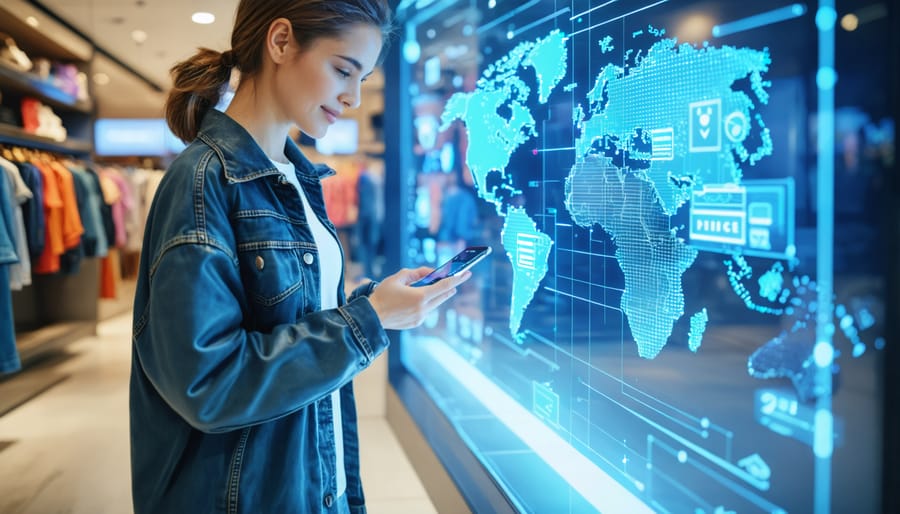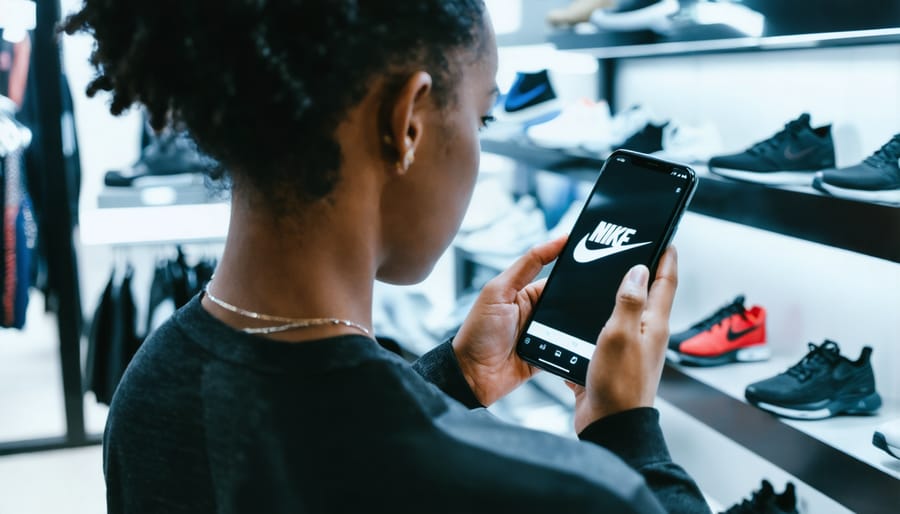Real-World Success Stories That Prove Omnichannel Retail Works

In today’s hyper-connected retail landscape, successful omnichannel strategies have become essential for building customer loyalty and driving sustainable growth. Leading retailers like Nike, Sephora, and Target have revolutionized customer experience by seamlessly integrating their physical stores, mobile apps, and online platforms. These industry pioneers demonstrate how strategic channel integration can transform traditional retail operations into dynamic, customer-centric ecosystems.
From Walmart’s innovative pickup towers to Starbucks’ mobile order-ahead functionality, modern omnichannel success stories showcase the power of connecting digital convenience with in-store experiences. These implementations aren’t just about technology—they represent a fundamental shift in how retailers engage with customers across every touchpoint.
This article explores real-world examples of successful omnichannel retail strategies, breaking down the key components that make them effective. Whether you’re a small business owner looking to expand your digital presence or an established retailer seeking to optimize your multichannel approach, these cases offer practical insights for creating seamless shopping experiences that meet modern consumer expectations.
Nike’s Seamless Shopping Experience
Mobile App Integration
Nike’s mobile app serves as a cornerstone of their omnichannel strategy, seamlessly connecting digital and physical shopping experiences. The Nike app offers features like Nike Scan, which allows customers to instantly access product information, check inventory, and read reviews by scanning items in-store. This integration enables personalized customer communications and recommendations based on shopping history and preferences.
The app’s Store Mode activates automatically when customers enter a Nike retail location, providing access to store-specific features and promotions. Shoppers can request items to try on through the app, with store associates preparing fitting rooms in advance. The Nike+ member benefits program, integrated within the app, offers exclusive access to limited-edition products and early access to sales.
One of the app’s most innovative features is Nike Fit, which uses digital foot measurement technology to recommend the perfect shoe size. Customers can save their measurements for future purchases, whether shopping online or in-store. The app also enables convenient services like Buy Online, Pick Up In-Store (BOPIS) and curbside pickup, allowing customers to seamlessly transition between digital and physical shopping experiences.
These mobile integrations have significantly improved customer engagement and satisfaction while providing valuable data insights for Nike’s retail operations.

In-Store Digital Innovation
Nike’s physical stores showcase cutting-edge digital integration that enhances the customer experience while seamlessly connecting online and offline channels. The Nike House of Innovation stores feature interactive screens and mobile app integration that allow customers to scan products for detailed information, check inventory levels, and read reviews instantly.
One of their most notable innovations is the Nike App at Retail, which transforms into “Store Mode” when customers enter a physical location. This feature enables shoppers to reserve items for fitting, request different sizes to be brought to their fitting room, and even skip the checkout line by paying through the app.
Digital lockers in stores allow customers to pick up online orders or store items while they continue shopping. The Nike Fit technology uses computer vision and AI to scan customers’ feet, providing precise size recommendations across different shoe styles, reducing returns and improving satisfaction.
Interactive mirrors in fitting rooms enable customers to request different sizes or colors without leaving the room, while digital displays throughout the store dynamically update with personalized recommendations based on customer preferences and past purchases.
These digital touchpoints create a fluid shopping experience where customers can move between physical and digital interactions naturally, while Nike captures valuable data about shopping behaviors and preferences to further personalize future experiences.
Sephora’s Beauty Insider Program
Digital Beauty Tools
Beauty retailers have revolutionized the omnichannel experience through innovative digital tools that seamlessly connect online and in-store shopping. Sephora’s Virtual Artist app stands out as a prime example, allowing customers to virtually try on makeup products using augmented reality technology. This tool enables shoppers to experiment with different cosmetics from home, save their favorite looks, and make informed purchasing decisions whether online or in-store.
The technology integrates with customers’ online beauty profiles, which track purchase history, product preferences, and Beauty Insider rewards across all channels. When customers visit physical stores, beauty advisors can access these profiles to provide personalized recommendations based on previous purchases and saved items.
MAC Cosmetics similarly employs virtual try-on technology in their stores through smart mirrors, while maintaining consistent product information and recommendations across their mobile app and website. These digital tools sync with customers’ profiles, allowing them to recreate looks they’ve saved online during in-store visits.
The success of these digital beauty tools lies in their ability to solve common customer pain points, such as uncertainty about color matches and product compatibility. By providing consistent, personalized experiences across all channels, these retailers have significantly increased customer engagement and sales conversion rates. The technology also helps reduce return rates by enabling customers to make more confident purchasing decisions.

Cross-Channel Rewards System
Sephora’s Beauty Insider program stands as a prime example of loyalty programs that drive revenue through seamless cross-channel integration. The beauty retailer’s rewards system functions uniformly across its mobile app, website, and physical stores, creating a cohesive shopping experience that encourages customer engagement across all touchpoints.
Members earn points regardless of where they shop, with purchases automatically tracked through a unique identifier linked to their account. The program’s digital integration allows customers to check their point balance, access personalized recommendations, and view purchase history through any channel. In-store, associates can instantly access customer profiles, including previous purchases and preferences, enabling personalized service that builds on online interactions.
What sets Sephora’s system apart is its strategic use of data collection across channels. The company leverages purchase history and browsing behavior to create targeted offers that can be redeemed both online and in-store. Digital receipts seamlessly sync with the mobile app, while in-store purchases immediately reflect in online profiles.
The program’s success lies in its ability to remove friction between channels while maintaining consistent value delivery. Customers can start their shopping journey on one platform and complete it on another without losing access to their rewards or personalized experiences. This approach has resulted in increased customer lifetime value and higher engagement rates across all shopping channels.
Target’s Digital-First Approach
Drive Up and Order Pickup
Target’s drive-up and order pickup services exemplify how traditional retailers can successfully blend digital convenience with physical store advantages. Since implementing these services, Target has reported a 273% increase in same-day services usage, with drive-up orders leading the growth.
The process is remarkably streamlined: customers place orders through Target’s mobile app or website, selecting either drive-up or in-store pickup options. For drive-up service, customers park in designated spots and notify staff through the app, receiving their orders within minutes without leaving their vehicles. In-store pickup allows customers to collect orders from service counters or self-service lockers, reducing wait times significantly.
These services have proven particularly valuable during peak shopping periods and have become a significant competitive advantage. Target reports that 95% of drive-up orders are ready within 10 minutes of customers’ arrival, and the service has achieved a 98% customer satisfaction rate.
The financial impact has been substantial, with Target’s digital sales growing by 145% year-over-year, largely attributed to these convenient pickup options. The company has also noted that customers using drive-up and pickup services typically spend 25% more per visit compared to traditional in-store shoppers.
By integrating these services with their existing store network, Target has effectively transformed their physical locations into mini-fulfillment centers, maximizing efficiency while meeting modern consumer expectations for convenience and speed.

Mobile App Features
Target’s mobile app serves as a cornerstone of their omnichannel strategy, seamlessly connecting the digital and physical shopping experience. The app features a user-friendly interface that allows customers to browse products, check in-store availability, and create shopping lists that sync across devices.
One of the app’s standout features is its integrated store navigation system. When shopping in-store, customers can use the app to locate specific items, with turn-by-turn directions guiding them through the aisles. The app also displays real-time inventory updates, helping shoppers confirm product availability before visiting their local store.
The Target app incorporates a sophisticated loyalty program through Target Circle, which automatically applies available discounts and tracks reward points. Customers can scan products in-store to check prices, read reviews, and compare variants, eliminating the need for separate price-check stations.
For enhanced convenience, the app offers multiple fulfillment options. Shoppers can switch between home delivery, curbside pickup, and in-store pickup with a few taps. The Drive Up service allows customers to place orders through the app and have items delivered directly to their car within minutes of arrival.
The app also features mobile payment integration through Target Wallet, which combines payment, coupons, and loyalty rewards in a single scan at checkout, significantly speeding up the transaction process while maintaining a consistent brand experience across all channels.
Implementation Strategies for Your Business
Implementing an omnichannel strategy requires careful planning and systematic execution. Here’s a step-by-step approach to help your business transition smoothly:
Start by auditing your current channels and customer touchpoints. Document how customers interact with your brand across different platforms and identify gaps in the customer journey. This assessment will form the foundation of your strategy.
Invest in a robust Customer Relationship Management (CRM) system that can integrate data from multiple channels. This central database will help you maintain consistent customer information and enable personalized experiences across all touchpoints. Consider implementing predictive analytics for customer retention to anticipate customer needs and behaviors.
Prioritize technology integration. Ensure your point-of-sale systems, inventory management, and e-commerce platforms can communicate seamlessly. This integration enables real-time inventory updates, consistent pricing, and synchronized customer data across channels.
Train your staff thoroughly on the omnichannel approach. Employees should understand how different channels work together and be able to assist customers regardless of their preferred shopping method. Create standard operating procedures for cross-channel interactions.
Develop a unified content strategy that maintains brand consistency across all channels while adapting to each platform’s unique characteristics. Your messaging should feel cohesive whether customers encounter it on social media, email, or in-store displays.
Start small and scale gradually. Begin by connecting your most important channels first, then expand based on customer feedback and business results. This approach allows you to test and refine your strategy while managing resources effectively.
Implement cross-channel capabilities such as:
– Buy online, pick up in-store (BOPIS)
– Mobile app integration with in-store experiences
– Unified loyalty programs across all channels
– Seamless returns across channels
– Consistent pricing and promotions
Monitor key performance indicators (KPIs) across channels, including:
– Cross-channel conversion rates
– Customer satisfaction scores
– Channel-specific engagement metrics
– Overall customer lifetime value
Regular analysis of these metrics will help you identify areas for improvement and optimize your omnichannel strategy over time. Remember to collect and act on customer feedback to ensure your implementation meets their needs and expectations.
The successful implementation of omnichannel retailing strategies has become crucial for businesses looking to thrive in today’s competitive marketplace. As demonstrated through various examples, companies that effectively integrate their physical and digital channels while maintaining consistent customer experiences across all touchpoints have seen significant improvements in customer satisfaction and retention rates.
Key takeaways from successful omnichannel retailers include the importance of seamless integration between online and offline channels, personalized customer experiences, and real-time inventory management. These strategies have proven essential in meeting modern consumer expectations for convenience, flexibility, and consistency in their shopping journey.
For businesses considering omnichannel adoption, the path forward requires careful planning and strategic implementation. Start by analyzing your current channels and identifying gaps in customer experience. Invest in technology that enables cross-channel integration and data sharing. Train your staff to understand and operate across all channels effectively. Most importantly, maintain focus on creating a unified brand experience that puts customer convenience first.
Remember that omnichannel retailing is not just a trend but a fundamental shift in how successful businesses operate. Those who embrace this approach position themselves to better serve their customers, increase loyalty, and drive sustainable growth. While the initial investment may be significant, the long-term benefits of increased customer satisfaction, higher retention rates, and improved operational efficiency make omnichannel implementation a crucial strategic priority for modern retailers.
Leave a Reply